Metal Detector Search Coils: Complete Guide

Written by Piotr Lesniewski
Detectorist • Scotland
As an Amazon Associate we earn commission from qualifying purchases. Read our full Affiliate Disclosure.
You’ve probably noticed the circular disk at the end of a metal detector, but do you understand its critical role in finding treasure? The search coil is more than just an accessory—it’s the heart of your detecting experience. Different sizes, shapes, and technologies can dramatically affect what you find and what you miss.
Whether you’re hunting coins in a trashy park or searching for deep relics, choosing the right coil could be the difference between success and walking away empty-handed.
Key Takeaways
- A search coil is the circular disc at the end of the detector’s shaft that actually detects metal objects.
- Coil sizes impact performance, with small coils (5-8″) excelling at precision, medium (9-11″) offering balance, and large (12+”) maximizing depth.
- Different coil shapes serve specific purposes: round for consistent detection, DD for mineralized soil, and concentric for pinpoint accuracy.
- Regular maintenance including cleaning, cable management, and using protective skid plates significantly extends coil lifespan.
- Upgrading your coil can address specific detection challenges like reaching deeper targets or improving performance in trashy areas.

What Is A Metal Detector Search Coil?
The heart of any metal detector, a search coil is the circular disc at the end of the detector’s shaft that actually detects metal objects. It contains wire windings that create an electromagnetic field when electricity passes through them.
When this field encounters metallic objects, it creates electrical eddy currents that produce a secondary magnetic field. Your detector’s electronics detect this disturbance and alert you with audio tones or visual indicators.
Search coils come in various shapes and sizes, each designed for specific hunting conditions. The coil’s construction, size, and configuration directly impact your detector’s depth capability, sensitivity, and ability to separate closely spaced targets.
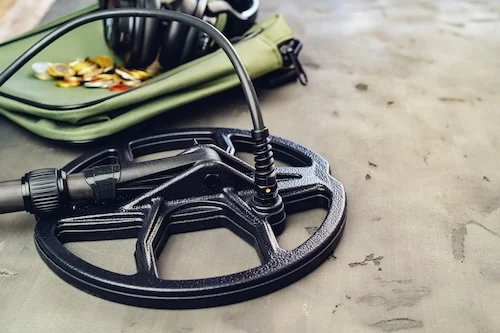
How Metal Detector Search Coils Work?
Understanding how search coils function reveals the fascinating physics that makes metal detection possible.
Your detector’s transmit coil generates an electromagnetic field that radiates into the ground you’re scanning. When this field encounters a metal object, it induces what are called eddy currents within the metal.
These eddy currents aren’t passive—they create their own secondary magnetic field around the object. Your detector’s receive coil then picks up these changes, and the circuitry interprets them, alerting you to the presence of metal.
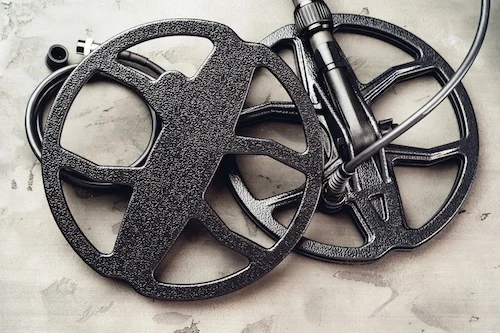
Coil Sizes and Applications
Choosing the right search coil size dramatically impacts your success. Small coils (5-8 inches) excel at precision, medium coils (9-11 inches) offer balance, and large coils (12+ inches) provide maximum depth.
Small Coils (5-8 inches)
When hunting in trashy areas, small coils measuring 5-8 inches excel at target separation, allowing you to distinguish between closely positioned items.
You’ll find them effective for pinpointing with precision and maneuvering around obstacles. They’re also less affected by ground mineralization.
However, these benefits come with tradeoffs. Small coils sacrifice depth capability and cover less ground per sweep.
For detailed searching in parks, playgrounds, and around old foundations, these limitations are often worth the improved accuracy.
Medium Coils (9-11 inches)
Most detectorists reach for medium-sized coils as their go-to option. These 9-11 inch coils offer an excellent balance between depth and target separation, making them versatile performers across most detecting scenarios.
When you’re searching farmland, beaches, or typical hunting grounds, medium coils provide reasonable coverage without sacrificing too much precision.
While they’re not specialized for extreme conditions, their versatility makes them the ideal starting point for most of your detecting adventures.
Large Coils (12+ inches)
Large coils push the boundaries of what’s possible. These 12+ inch powerhouses excel at reaching maximum depth and covering ground efficiently, making them ideal for relic hunting in open fields or searching for caches.
However, these advantages come with tradeoffs. You’ll struggle with target separation in trashy areas, and they are heavier and more tiring to swing. Small targets often go undetected.
For beach detecting or covering vast areas quickly, large coils are your best option.
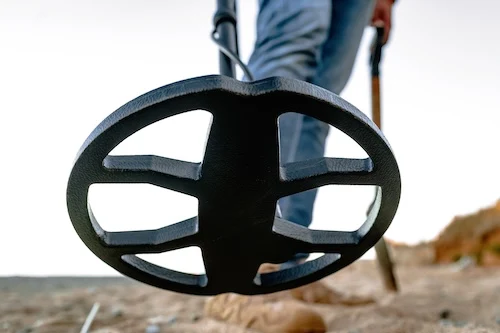
Metal Detector Coil Shapes
The shape of your coil significantly affects its performance. You’ll encounter three main shapes: circular/round, elliptical/DD, and concentric.
Circular/Round Coils
Circular coils are the industry standard for good reason. Their popularity stems from their ability to deliver consistent, even detection patterns.
When you’re searching, you’ll appreciate the balanced depth and sensitivity these coils provide. One of the most significant advantages is how easily you can overlap your search patterns, ensuring you don’t leave gaps where valuable items might remain hidden.
Elliptical/DD (Double-D) Coils
Elliptical Double-D coils represent the next evolution in detection technology. These coils feature a knife-edge detection pattern that significantly improves your target separation capabilities.
DD coils truly shine in challenging environments. They provide superior performance in mineralized soil thanks to their enhanced ground balancing capabilities.
Many modern detectors now include DD coils as standard equipment, recognizing their advantages in most hunting conditions.
Concentric Coils
When accuracy matters most, concentric coils provide unmatched precision. These coils emit a cone-shaped detection pattern that narrows as it penetrates deeper, allowing you to pinpoint targets with exceptional accuracy.
You’ll find concentric coils excel at providing better depth on coin-sized objects compared to other coil types. Their predictable, symmetrical pattern helps you develop consistent sweeping techniques.
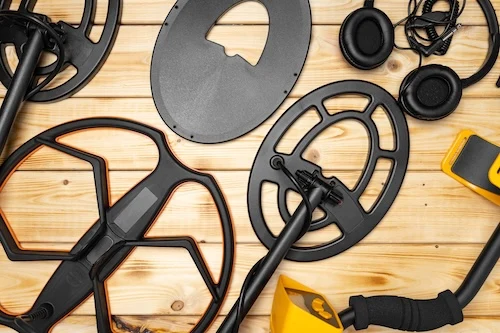
Specialized Coil Types
Specialized coils give you the flexibility to hunt in unique environments.
Waterproof Coils
Waterproof coils offer peace of mind when hunting near lakes, rivers, or beaches. These coils are specifically sealed against water ingress, making them essential for beach and underwater detecting.
When purchasing a waterproof coil, you’ll need to carefully check the depth ratings. Some are merely splashproof, while others are fully submersible.
High-Frequency Coils
High-frequency coils are the pinnacle of precision. These specialized coils give you a significant advantage when searching for small gold nuggets and jewelry that might otherwise go unnoticed.
Be aware that this enhanced sensitivity comes with a trade-off. In highly mineralized ground, high-frequency coils may produce more noise and false signals.
Low-Frequency Coils
Low-frequency coils offer distinct advantages for different scenarios. These coils typically operate below 15 kHz and penetrate deeper into the ground, making them ideal for locating larger, buried objects like relics and caches.
The trade-off is reduced sensitivity to tiny objects. You’ll find them particularly effective in mineralized soil where high-frequency options struggle.
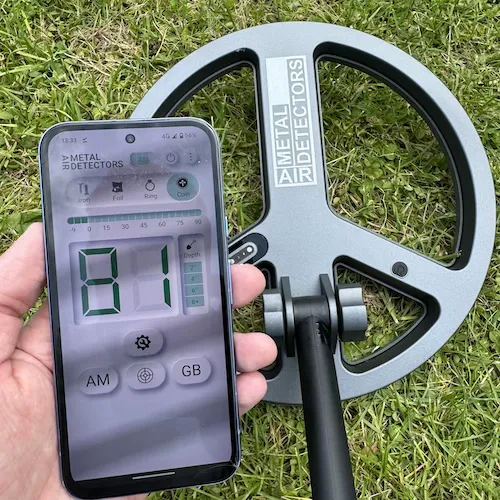
Best Metal Detector Coil To Use Per Environment
Choosing the right coil for your environment can dramatically impact your finds.
Parks and Schools
These locations contain a mix of coins, jewelry, and lots of trash. Your best option is an 8-10 inch concentric or DD coil. These medium-sized coils offer excellent target separation, allowing you to distinguish between closely spaced items in trash-heavy areas.
Beaches
Beaches present unique challenges: salt mineralization, vast search areas, and shifting sands. For beach detecting, you’ll want to equip your machine with a 10-12 inch waterproof DD coil. The DD design handles the high mineralization from salt, and the larger size allows you to cover more ground efficiently.
Farmland/Open Fields
When searching vast farmland or open fields, efficiency is key. For most farmland scenarios, an 11-15 inch coil is your best option. The larger size provides excellent coverage and impressive depth capabilities in clean soil conditions.
Wooded Areas
Hunting through wooded areas calls for a different strategy. An 8-9 inch round coil is your best option for wooded environments. This size strikes the perfect balance between coverage and maneuverability, allowing you to weave between trees and navigate around obstacles.
Prospecting/Gold Hunting
Gold hunting success hinges on your choice of coil. A compact coil between 5-8 inches in diameter will dramatically improve your chances of success. These smaller coils offer superior sensitivity to tiny gold nuggets that larger coils might miss entirely. High-frequency coils further enhance this sensitivity.

Proper Metal Detector Coil Maintenance and Care
To extend your coil’s lifespan, establish regular maintenance habits.
Cleaning
After each beach hunt, thoroughly rinse your coil with fresh water to remove salt and sand. For stubborn dirt, use a mild soap solution and a soft cloth. Never use harsh chemicals.
Protection
Invest in quality coil covers or skid plates that serve as a barrier between your coil and rough terrain. Don’t drag your coil across rocky surfaces. When traveling, store it in a padded case.
Cable Management
The coil cable is typically the first component to fail in metal detector systems, making proper management essential for long-term performance.
Always avoid creating sharp bends or kinks. Use velcro wraps or built-in clips to maintain gentle curves. Replace worn cables promptly to prevent signal loss.
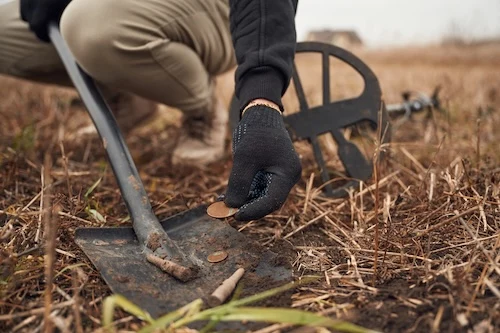
When to Consider Upgrading Your Metal Detectors Coil
If you’re struggling to reach deep targets or navigate trashy areas effectively, a specialized coil can dramatically improve your results. When your original coil shows signs of wear, it’s the perfect opportunity to upgrade.
Before purchasing, verify compatibility with your detector’s frequency and physical connectors.
How To Optimise Your Coils Performance
To optimize performance, master ground balancing, refine your swing technique, and adjust your detector’s settings.
Ground Balancing
When you switch between coils, don’t forget to re-balance your detector, even if you’re hunting in the same location. Each coil design responds differently to mineralization.
Swing Technique
Keep your search coil at a consistent height of 1-2 inches above the surface. As you sweep, ensure each pass overlaps the previous one by 25-50%. Adjust your swing speed according to coil size—larger coils require slower movements.
Settings Adjustment
Larger coils typically need lower sensitivity settings to prevent false signals. As you switch coil sizes, you’ll need to adjust discrimination patterns accordingly. Fine-tune your threshold and tone settings based on your specific coil’s response.
Conclusion
Your search coil is the most crucial component of your metal detector. By understanding the different sizes, shapes, and specialized types, you’ll make better choices for your detecting environment. Remember to maintain your coil properly and consider upgrades when performance lags. With the right coil and proper technique, you’ll maximize your finds and enjoy more successful treasure hunting adventures.
Author Profile

Piotr Lesniewski
"Digging up the past, one signal at a time."
Polish-born, Scotland-based, and obsessed with the beep. My passion began decades ago, exploring fields with my Dziadek (grandfather). Now, with over 10 years of digging under my belt, I'm here to share everything I've learned—unfiltered and unbiased—to help you unearth your own piece of history. No sales pitches, just real field experience.